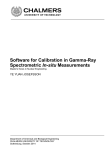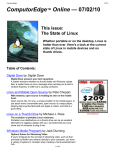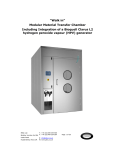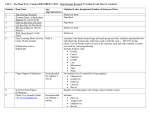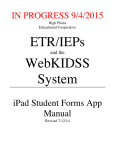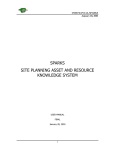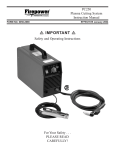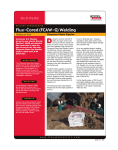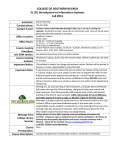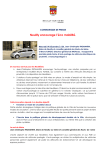Download March 2013 Newsletter
Transcript
Volume 29 Issue 1 March 2013 Director’s Log By Mike Durham. Springtime is here! Tomato plants on sale! Fish are biting. What a wonderful time of the year! This spring we will be rolling out some new procedures to the campus community on accident prevention and follow-up. The effort will be to implement the provisions of our Safety Improvement Plan, which includes implementing the revisions of PS 90 Workers’ Compensation and Work Related Accidents, and PS 67 Misuse of Drugs or Alcohol . You will find the revised policies on the LSU Policies and Procedures website. I am excited about introducing the new emphasis elements on prevention, safety training, first aid provision, accident investigations and getting employees back to work. We are also implementing improved compliance with the provisions of PS 67, to increase emphasis on preventing alcohol and drug abuse and reducing its impact on our safety and security on and off campus. Remember to report promptly all accidents that occur on campus and any incident where damage may have occurred to property. It is important that we know immediately of any accident or incident so that we can review the incident immediately. Our goal is to get to the scene quickly and assure that we have all the information we need to address the matter. Once the participants are gone, witnesses are hard to find, and information gets stale. You can call LSU Police to report any incident relating to safety and security at 578 3231. Accidents can be reported on line at www.ehs.lsu.edu. If you have questions or wish to make suggestions about safety, call our office at 578 5640. Have a great Springtime! “Seventy years”. Plus a “$14,000 fine”. Although I was not in the courtroom, I know the words of the judge had impact. The case was a trial of a 30 year old Greensburg man who had been apparently celebrating his birthday and drinking at the golf course, and then got on the road behind the wheel of his pickup truck. He caused a wreck near Slaughter, killing 7 members of a group heading home from a church service. Six were from the same family. He pleaded guilty to seven counts of vehicular homicide and was given 7 consecutive sentences, each 10 years, for each of the people killed. He will be eligible for parole at about 23 years, according to news reports, when “good time” is counted. The families are devastated, the driver remorseful, and forgiveness was expressed after the sentence was passed down. A tragedy like this has no redeeming features, but one thing it provides is the clear effect of alcohol on driving. I was reading the paper this morning and saw the report of 9 people who were arrested for drunk driving during a period that included Saturday night in East Baton Rouge Parish. One was a third offense, another a second offense. During a similar period that included last Thursday night, there were 17 arrests. This tells me that the risks are great for a similar tragedy to occur on any given night. Good people drink. But it is not a matter of good people vs. bad people. Everyone who drives and also drinks must keep in mind that a wreck that takes lives like the one that is described above can happen, and will destroy not only the lives of the victims, but also will have devastating effects on the person who is driving and his/ her passengers and family. The risk is too high. Always plan ahead, and avoid getting behind the wheel after drinking. We want to avoid what the families above have endured. Inside This Issue Slip-Trip-Fall Prevention 2 Chemical Safety– Container Condition 3 Autoclave use and Validation Policy 4 APRIL– Distracted Driver Awareness Month 6 2 LSU Life Line EHS has introduced a new training and awareness initiative called “WATCH YOUR STEP”. Slips, Trips & Falls are the leading cause of workplace injuries in our nation’s workforce, and LSU is no exception. Twenty-three percent (23%) of all accidents reported to LSU Risk Management in 2012 were due to slips, trips and falls. To reinforce awareness on campus, posters (as shown above) will be exhibited in prominent locations around campus to raise employee awareness of this problem. Also, a short “Slip, Trip & Fall” presentation is available on the EHS website Training Section for employee safety meetings. (By Thomas Walsh) 3 LSU Life Line Chemical Safety - Chemical Containers in Poor Condition By Lisa Pepitone Adverse consequences: Containers in poor condition can result in leakage of hazardous chemicals. This increases the risk of exposure to hazardous chemicals. “Inherently waste-like chemicals” include expired chemicals, chemicals in deteriorating containers and chemicals that appear to be or are unusable. State inspectors may issue fines or infractions for inherently waste-like chemicals in your laboratory. Do not keep chemicals past their expiration date. Do not keep chemicals that have faded labels, deteriorating containers, leaks, and/or other obvious signs that the chemicals are not being used and are very likely to not be used in the future. Corrective action: All chemical containers must be in good condition with no visible damage or deterioration. Caps must be secure, intact, and without chemical residue. Labels must be intact, and fully legible. Any container found to be leaking, rusted, or forming precipitates must be disposed of immediately as chemical waste. Stored chemicals shall be examined at least annually by the person in charge of the laboratory for replacement, deterioration, and container integrity. Conduct cleanouts when you do your annual chemical inventory update. Itemize chemicals to be removed, and submit the list to EHS for a chemical waste pick-up. Images below are chemicals recently collected from the Choppin and Life Sciences Buildings. 4 LSU Life Line Autoclave Use and Validation Policy Adopted April 26, 2012 by the LSU Inter-Institutional Biological and Recombinant DNA Safety Committee (IBRDSC) Requires operator training, written SOPs, and use of PPE Autoclaves can pose physical hazards (i.e., heat, steam and pressure) and biological hazards. (i.e., inadequately sterilized infectious materials). All PIs at LSU are required to train their personnel on the proper use, validation and maintenance of autoclaves they will use in their department. Different varieties of autoclaves may have their own unique characteristics for loading, load sizes, cycle types and cycle settings. The materials to be sterilized will determine the sterilization cycle that will be used. For this reason, it is important to read and understand the user’s manual for the specific model of autoclave that is being used. Be certain that the user’s manual is readily available in case questions or concerns arise during the operation of the autoclave. The following are the responsibility of the PI or Supervisor: A. Training: The supervisor for each laboratory should develop and implement an autoclave safety training program. All users shall be trained before operating an autoclave; the supervisor is responsible for ensuring that each person in the lab is properly trained. All training must be documented and the records maintained in the lab with other safety training materials. These records will be reviewed during Environmental Health and Safety Inspections. B. Maintenance & Use: Autoclave maintenance is essential for a safe and properly functioning autoclave. The manufacturer’s recommendations should be followed for preventative maintenance. All contractors hired to perform regular maintenance and repairs should be approved by the manufacturer. Each autoclave user is responsible for ensuring the autoclave is monitored as follows: Heat Sensitive Tape Monitoring — All operators shall use heat sensitive sterilization indicator tape for each load. Tape will only indicate that the proper temperature for the cycle has been reached. Tape will not indicate that the load was heated at the proper pressure or for the appropriate length of time. Be certain that the heat sensitive tape does not contain a lead base indicator. This type of tape must be collected and managed as hazardous waste. Biological Indicators — All operators that autoclave infectious/biohazardous waste must do the following: At least once a month use a biological indicator such as Geobacillus stearotherophilus placed at the center of a load processed to confirm adequate sterilization conditions. Remember for the autoclave to sterilize the steam must penetrate what you are autoclaving. Maintain these validation records. C. Recordkeeping: Documentation records of any autoclave preventative maintenance/repairs and validations shall be maintained. These records will be reviewed during your next inspection. The records should indicate who performed the work, the type of maintenance or repairs conducted and the date the autoclave was serviced. Biological indicator validation records and test results shall also be maintained. Records should be kept in the room with the autoclave, or there should be a sign indicating where the records are located. Continued on page 5 5 LSU Life Line AUTOCLAVE USE and Validation (Continued from page 4) D. Disposal: Once waste has been properly inactivated via autoclave, the orange/red biohazard/autoclave bags MUST be placed in regular black garbage bags before being transferred to the garbage dumpsters outside of buildings. Disposal companies will refuse to pick-up loads containing visible biohazard/autoclave bags. These bags are also NEVER to be left on loading docks or the ground next to dumpsters. Autoclave Failure: Discontinue use immediately if an autoclave is not working properly. Post a sign alerting others not to use the autoclave. Include the date and your contact information. Mechanical failures need to be attended to by a trained technician. Contact the service company responsible for the maintenance of your autoclave or your department’s safety representative for further guidance. Burn Emergency: If you are burned, you should seek medical treatment immediately. Burns to the face, third-degree burns or burns over large areas of the body should be treated as emergencies (Call 911). Minor burns should be treated by using first aid procedures, including immersing the burn in cool water immediately, removing clothing from the burn area and keeping the injured area cool for at least 5 minutes. Regardless of the severity, notify your supervisor. For non-life threatening burns call or proceed to the Student Health Center. Report any accidents: https://sites01.lsu.edu/wp/ehs/accident-report/ Additional information along with the complete policy can be found on the EHS website at: https:// sites01.lsu.edu/wp/ehs/biological-safety-policies-and-guide-lines/ 6 LSU Life Line ++++ Safety Meetings ++++ Distracted Driving Awareness Month Thousands die needlessly each year because people continue to use their cell phones while driving, handheld or hands-free. Join the National Safety Council this April in urging those you care about to: Stop using cell phones while driving Understand the dangers of the cognitive distraction to the brain Inform people who call you while driving that you'd be happy to continue the conversation once they have reached their destination Tell others about the dangers of cell phone distracted driving (more information is available from the National Safety Council– www.nsc.org) Is Safe Driver training required annually to drive on State Business? ANSWER: Driver Training is required every 3 years, and must be repeated when one receives a traffic citation. The Driver’s Authorization form should be completed Annually. Is there a State Policy on using cell phones while driving on state business? As a minimum, Department Safety meetings should be conducted Quarterly. This newsletter can be used as safety meeting material. Please route through your department via e-mail and request a “return receipt,” or circulate with “sign-in” sheet containing printed name/date/ and initial. Office of Environmental Health and Safety (E.H.S.) 201C Copy and Mail Center South Stadium Drive 578-5640 www.ehs.lsu.edu Mike Durham, Director Mike Hooks, Assistant Director Greg Hayes, Manager, Biological Safety Quinesha Morgan, Biological Safety Coordinator Jerry Steward, Manager, Chemical Safety Thomas Walsh, Health and Safety Officer Lisa Pepitone, Environmental and Emergency Response Coordinator Jason LeJeune-Manager, Laboratory Safety Patrick West, Manager, Environmental and Safety Training Joyce Gibbs, Administrative Coordinator ANSWER: the State Office of Risk Management states that Employees shall not use a Wireless Telecommunications Device while driving in a state owned, leased, or private vehicle that is being driven on state business. LSU IS AN EQUAL OPPORTUNITY/ACCESS UNIVERSITY






